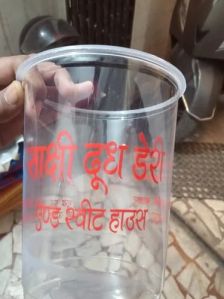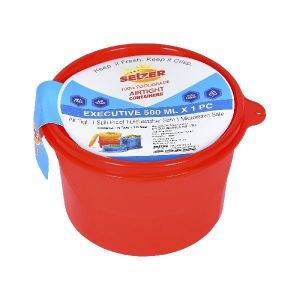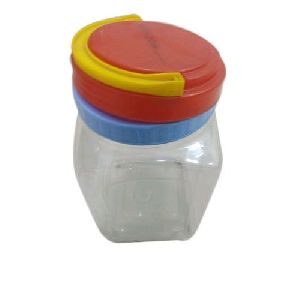
pet cans
19 - 20 Per Per unit
Pet cans green ND white 5ltr

Plastic Storage Jar
10 - 12 Per Piece
1000 Piece (MOQ)
Best Deals from Plastic Jar

Round Disposable Plastic Container
7 Per Piece
1000 Piece (MOQ)

Polypropylene Container 500ml
25 - 26 Per piece
24 Piece (MOQ)

PP Container
Get Price Quote
We are engaged in providing superlative quality PP Container to the esteemed clients. These PP Containers are used for packing of Epoxy, Paints, Glue, and various other items. The lid of PP Container is tight fit but easy to open as it opens only when pressure is applied at a certain angle.

PET Jars and Bottles
Get Price Quote
Polyethylene terephthalate (sometimes written poly(ethylene terephthalate)), commonly abbreviated PET, PETE, or the obsolete PETP or PET-P, is a thermoplastic polymer resin of the polyester family and is used in synthetic fibers; beverage, food and other liquid containers; thermoforming applications; and engineering resins often in combination with glass fiber.Depending on its processing and thermal history, polyethylene terephthalate may exist both as an amorphous (transparent) and as a semi-crystalline polymer. The semicrystalline material might appear transparent (particle size < 500 nm) or opaque and white (particle size up to a few microns) depending on its crystal structure and particle size. Its monomer (bis-β-hydroxyterephthalate) can be synthesized by the esterification reaction between terephthalic acid and ethylene glycol with water as a byproduct, or by transesterification reaction between ethylene glycol and dimethyl terephthalate with methanol as a byproduct. Polymerization is through a polycondensation reaction of the monomers (done immediately after esterification/transesterification) with ethylene glycol as the byproduct (the ethylene glycol is directly recycled in production).The majority of the world's PET production is for synthetic fibers (in excess of 60%) with bottle production accounting for around 30% of global demand. In discussing textile applications, PET is generally referred to as simply "polyester" while "PET" is used most often to refer to packaging applications. The polyester industry makes up about 18% of world polymer production and is third after polyethylene (PE) and polypropylene (PP).UsesSailcloth is typically made from PET fibers also known as polyester or under the brand name Dacron; colorful lightweight spinnakers are usually made of nylon.PET can be semi-rigid to rigid, depending on its thickness, and it is very lightweight. It makes a good gas and fair moisture barrier, as well as a good barrier to alcohol (requires additional "barrier" treatment) and solvents. It is strong and impact-resistant. It is naturally colorless with a high transparency.Plastic bottles made from PET are excellent barrier materials and are widely used for soft drinks (see carbonation). For certain specialty bottles, PET sandwiches an additional polyvinyl alcohol to further reduce its oxygen permeability.Biaxially oriented PET film (often known by one of its trade names, "Mylar") can be aluminized by evaporating a thin film of metal onto it to reduce its permeability, and to make it reflective and opaque (MPET). These properties are useful in many applications, including flexible food packaging and thermal insulation, such as "space blankets". Because of its high mechanical strength, PET film is often used in tape applications, such as the carrier for magnetic tape or backing for pressure sensitive adhesive tapes.Non-oriented PET sheet can be thermoformed to make packaging trays and blisters. If crystallizable PET is used, the trays can be used for frozen dinners, since they withstand both freezing and oven baking temperatures.When filled with glass particles or fibers, it becomes significantly stiffer and more durable. This glass-filled plastic, in a semi-crystalline formulation, is sold under the tradename Rynite, Arnite, Hostadur, and Crastin.While most thermoplastics can, in principle, be recycled, PET bottle recycling is more practical than many other plastic applications. The primary reason is that plastic carbonated soft drink bottles and water bottles are almost exclusively PET. PET has a resin identification code of 1. One of the uses for a recycled PET bottle is for the manufacture of polar fleece material. Among its many uses, companies such as English Retreads use the PET material to line their products. It can also make fiber for polyester products.Because of the recyclability of PET and the relative abundance of post-consumer waste in the form of bottles, PET is rapidly gaining market share as a carpet fiber. Mohawk Industries released everSTRAND in 1999, a 100% post-consumer recycled content PET fiber. Since that time, more than 17 billion bottles have been recycled into carpet fiber.[4] Pharr Yarns, a supplier to numerous carpet manufacturers including Looptex, Dobbs Mills, and Berkshire Flooring,produces a BCF (bulk continuous filament) PET carpet fiber containing a minimum of 25% post-consumer recycled content.PET, as with many plastics, is also an excellent candidate for thermal disposal (incineration), as it is composed of carbon, hydrogen, and oxygen, with only trace amounts of catalyst elements (but no sulfur). PET has the energy content of soft coal.PET was patented in 1941 by the Calico Printers' Association of Manchester. The PET bottle was patented in 1973 by Nathaniel Wyeth.One of the most important characteristics of PET is referred to as intrinsic viscosity (IV)The intrinsic viscosity of the material, measured in deciliters per gram (dℓ/g) is dependent upon the length of its polymer chains. The longer the polymer chains, the more entanglements between chains and therefore the higher the viscosity. The average chain length of a particular batch of resin can be controlled during polycondensation.The intrinsic viscosity range of PETFiber grade0.40 – 0.70 dℓ/g Textile0.72 – 0.98 dℓ/g Technical, tire cordFilm grade0.60 – 0.70 dℓ/g BoPET (biaxially oriented PET film)0.70 – 1.00 dℓ/g Sheet grade for thermoformingBottle grade0.70 – 0.78 dℓ/g Water bottles (flat)0.78 – 0.85 dℓ/g Carbonated soft drink gradeMonofilament1.00 – 2.00 dℓ/g[edit]Drying

Confectionery Plastic Jar
16 Per Piece

Plastic Containers
Get Price Quote
Plastic Paint Containers, plastic paint lubricant bucket

pp battery containers
Get Price Quote
pp battery containers, Pvc Battery Separator, ERICKSHAW BATTERIES

Plastic Pet Jars
Get Price Quote
Plastic Pet Jars, household plastic, Swing Dustbin, Kitchen Container

hdpe jar
Get Price Quote
hdpe jar

Pet Jars
Get Price Quote
Injection Moulded Plastic Components, Plastic Moulds, Injection Moulds

Pet Jar
Get Price Quote

Plastic Containers
Get Price Quote

HDPE Spice Jar
Get Price Quote
HDPE Spice Jar

Pet Jars
Get Price Quote
Pet Bottle Balled and Bottle Scrap, Clear Bottle and Road Waste Bottle

Plastic Pet Jars
Get Price Quote
Plastic Pet Jars, Bottles

Plastic Container
Get Price Quote

Food Container
Get Price Quote
plastic lubricant container, bio fertilizer container, Lubricant Container

Plastic Containers
Get Price Quote
Plastic Bowls, plastic jug

pp jars
Get Price Quote
pp jars, ldpe bottles, Metal Molded Products

Plastic Jars
Get Price Quote
injection moulding items, Bottle Caps

Hdpe Jars
Get Price Quote

Mineral Water Jar
Get Price Quote
Mineral Water Jar, Inkjet Printers, Hologram, Packing Material, jar

Plastic Containers
Get Price Quote
industrial packaging containers, big containers

Plastic Pet Jar
Get Price Quote
Plastic Pet Jar

Pet Jars
Get Price Quote

Plastic Container
Get Price Quote

disposable plastic food container
Get Price Quote

Plastic Food Container
Get Price Quote
plastic food packaging, Plastic Spoon, Plastic Forks